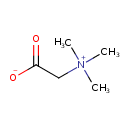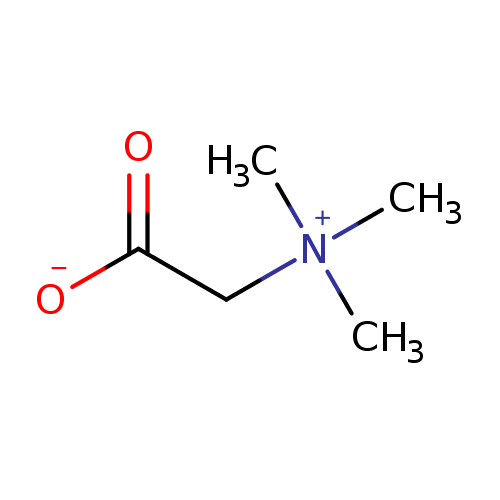|
Record Information |
|---|
| Version |
1.0 |
|---|
| Update Date |
1/22/2018 11:54:54 AM |
|---|
|
Metabolite ID | PAMDB110681 |
|---|
|
Identification |
|---|
| Name: |
glycine betaine |
|---|
| Description: | The amino acid betaine derived from glycine. |
|---|
|
Structure |
|
|---|
| Synonyms: | -
oxyneurine
-
lycine
-
acidin-pepsin
-
betaine
-
trimethylammonioacetate
-
N,N,N-trimethylglycine
|
|---|
|
Chemical Formula: |
C5H11NO2
|
|---|
| Average Molecular Weight: |
117.15 |
|---|
| Monoisotopic Molecular
Weight: |
118.0868036346 |
|---|
| InChI Key: |
KWIUHFFTVRNATP-UHFFFAOYSA-N |
|---|
| InChI: |
InChI=1S/C5H11NO2/c1-6(2,3)4-5(7)8/h4H2,1-3H3 |
|---|
| CAS
number: |
107-43-7 |
|---|
| IUPAC Name: | (trimethylammonio)acetate |
|---|
|
Traditional IUPAC Name: |
Bet |
|---|
| SMILES: | C[N+](C)(CC([O-])=O)C |
|---|
|
Chemical Taxonomy |
|---|
|
Taxonomy Description | This compound belongs to the class of organic compounds known as alpha amino acids. These are amino acids in which the amino group is attached to the carbon atom immediately adjacent to the carboxylate group (alpha carbon). |
|---|
|
Kingdom |
Organic compounds |
|---|
| Super Class | Organic acids and derivatives |
|---|
|
Class |
Carboxylic acids and derivatives |
|---|
| Sub Class | Amino acids, peptides, and analogues |
|---|
|
Direct Parent |
Alpha amino acids |
|---|
| Alternative Parents |
|
|---|
| Substituents |
- Alpha-amino acid
- Quaternary ammonium salt
- Tetraalkylammonium salt
- Carboxylic acid salt
- Monocarboxylic acid or derivatives
- Carboxylic acid
- Organopnictogen compound
- Hydrocarbon derivative
- Organic salt
- Organic oxygen compound
- Organooxygen compound
- Organonitrogen compound
- Carbonyl group
- Amine
- Organic nitrogen compound
- Organic oxide
- Aliphatic acyclic compound
|
|---|
| Molecular Framework |
Aliphatic acyclic compounds |
|---|
| External Descriptors |
|
|---|
|
Physical Properties |
|---|
| State: |
Solid |
|---|
| Charge: | 0 |
|---|
|
Melting point: |
293 - 301 °C |
|---|
| Experimental Properties: |
| Property | Value | Reference |
|---|
| Melting Point | 293 - 301 °C | Not Available | | Boiling Point | Not Available | Not Available | | Water Solubility | 611.0 mg/mL at 19 °C | Not Available | | LogP | Not Available | Not Available |
|
|---|
| Predicted Properties |
|
|---|
|
Biological Properties |
|---|
| Cellular Locations: |
Not Available |
|---|
| Reactions: | |
|---|
|
Pathways: |
|
|---|
|
Spectra |
|---|
| Spectra: |
| Spectrum Type | Description | Splash Key | |
|---|
| Predicted GC-MS | Predicted GC-MS Spectrum - GC-MS | Not Available |
|---|
| LC-MS/MS | LC-MS/MS Spectrum - Quattro_QQQ 10V, Positive (Annotated) | splash10-014i-0900000000-feacc600820771d2a77b | View in MoNA |
|---|
| LC-MS/MS | LC-MS/MS Spectrum - Quattro_QQQ 25V, Positive (Annotated) | splash10-0a4i-9000000000-e5bbda9fb66994576062 | View in MoNA |
|---|
| LC-MS/MS | LC-MS/MS Spectrum - Quattro_QQQ 40V, Positive (Annotated) | splash10-0a4i-9000000000-c382759eab7d0a87ac27 | View in MoNA |
|---|
| LC-MS/MS | LC-MS/MS Spectrum - LC-ESI-QQ (API3000, Applied Biosystems) 10V, Positive | splash10-014i-0900000000-a7beb42e6944181ae5d9 | View in MoNA |
|---|
| LC-MS/MS | LC-MS/MS Spectrum - LC-ESI-QQ (API3000, Applied Biosystems) 20V, Positive | splash10-014i-1900000000-77fbc4a2b76030d53644 | View in MoNA |
|---|
| LC-MS/MS | LC-MS/MS Spectrum - LC-ESI-QQ (API3000, Applied Biosystems) 30V, Positive | splash10-0a4i-9100000000-2941e4997f202293bf71 | View in MoNA |
|---|
| LC-MS/MS | LC-MS/MS Spectrum - LC-ESI-QQ (API3000, Applied Biosystems) 40V, Positive | splash10-0a4i-9000000000-9b9e3cecb77ed4b40b7c | View in MoNA |
|---|
| LC-MS/MS | LC-MS/MS Spectrum - LC-ESI-QQ (API3000, Applied Biosystems) 50V, Positive | splash10-0a4i-9000000000-27bbb5f9642306216a0b | View in MoNA |
|---|
| LC-MS/MS | LC-MS/MS Spectrum - LC-ESI-QTOF (UPLC Q-Tof Premier, Waters) , Positive | splash10-014i-1900000000-82a41cbb0f697910b577 | View in MoNA |
|---|
| LC-MS/MS | LC-MS/MS Spectrum - LC-ESI-QTOF (UPLC Q-Tof Premier, Waters) 30V, Positive | splash10-0aor-9500000000-9a0f1853188052d798c6 | View in MoNA |
|---|
| MS | Mass Spectrum (Electron Ionization) | splash10-0a4l-9000000000-f32989f795eeceb8b692 | View in MoNA |
|---|
| 1D NMR | 1H NMR Spectrum | Not Available |
|---|
| 1D NMR | 13C NMR Spectrum | Not Available |
|---|
| 2D NMR | [1H,1H] 2D NMR Spectrum | Not Available |
|---|
| 2D NMR | [1H,13C] 2D NMR Spectrum | Not Available |
|---|
|
|---|
|
References |
|---|
| References: |
- Atkinson W, Elmslie J, Lever M, Chambers ST, George PM (2008)Dietary and supplementary betaine: acute effects on plasma betaine and homocysteine concentrations under standard and postmethionine load conditions in healthy male subjects. The American journal of clinical nutrition 87, Pubmed: 18326594
- Lee EC, Maresh CM, Kraemer WJ, Yamamoto LM, Hatfield DL, Bailey BL, Armstrong LE, Volek JS, McDermott BP, Craig SA (2010)Ergogenic effects of betaine supplementation on strength and power performance. Journal of the International Society of Sports Nutrition 7, Pubmed: 20642826
- Ueland PM (2011)Choline and betaine in health and disease. Journal of inherited metabolic disease 34, Pubmed: 20446114
- Lever M, Slow S (2010)The clinical significance of betaine, an osmolyte with a key role in methyl group metabolism. Clinical biochemistry 43, Pubmed: 20346934
- Ueland PM, Holm PI, Hustad S (2005)Betaine: a key modulator of one-carbon metabolism and homocysteine status. Clinical chemistry and laboratory medicine 43, Pubmed: 16197300
- Roux A, Xu Y, Heilier JF, Olivier MF, Ezan E, Tabet JC, Junot C (2012)Annotation of the human adult urinary metabolome and metabolite identification using ultra high performance liquid chromatography coupled to a linear quadrupole ion trap-Orbitrap mass spectrometer. Analytical chemistry 84, Pubmed: 22770225
|
|---|
| Synthesis Reference: |
Mu, Yun; Guo, Xiao-hui. Improved process for preparation of betaine. Huaxue Yu Shengwu Gongcheng (2005), 22(7), 48-49. |
|---|
| Material Safety Data Sheet (MSDS) |
Download (PDF) |
|---|
|
Links |
|---|
| External Links: |
|
|---|


